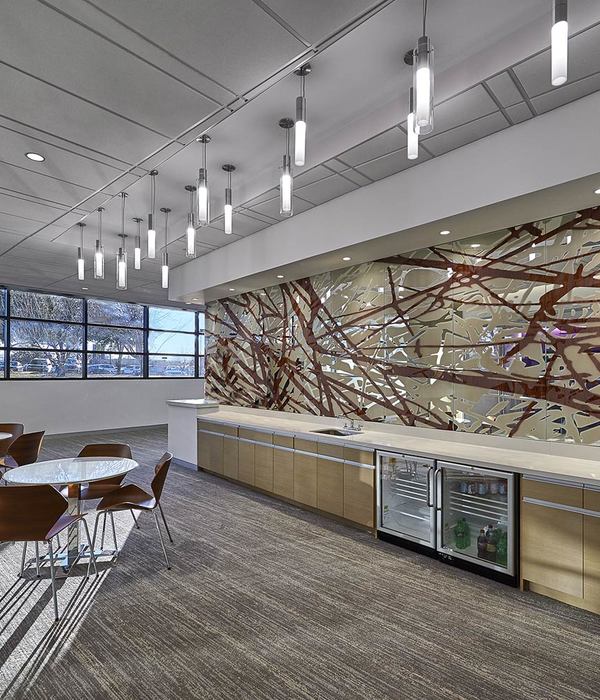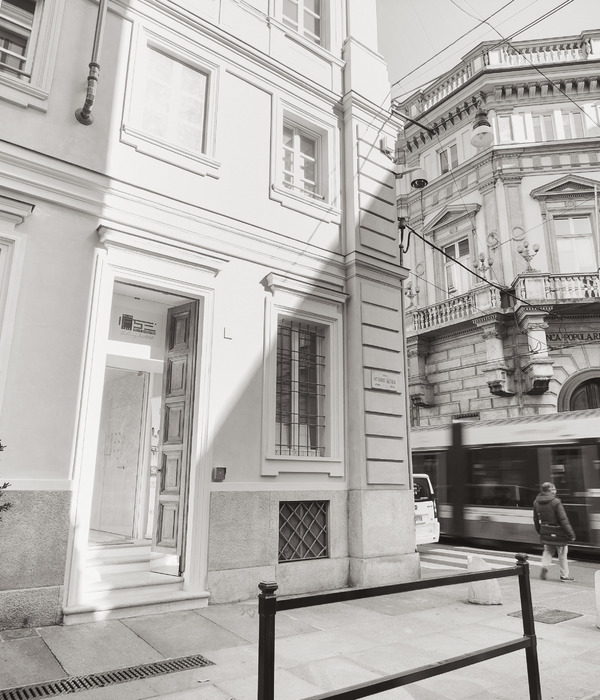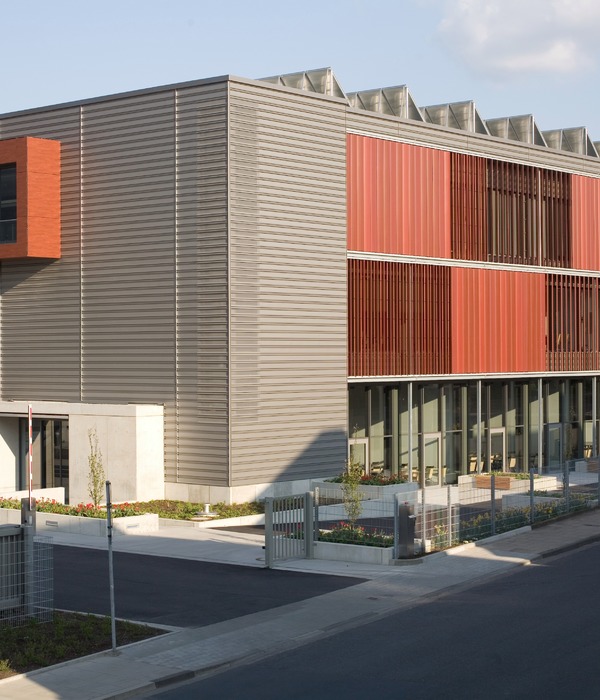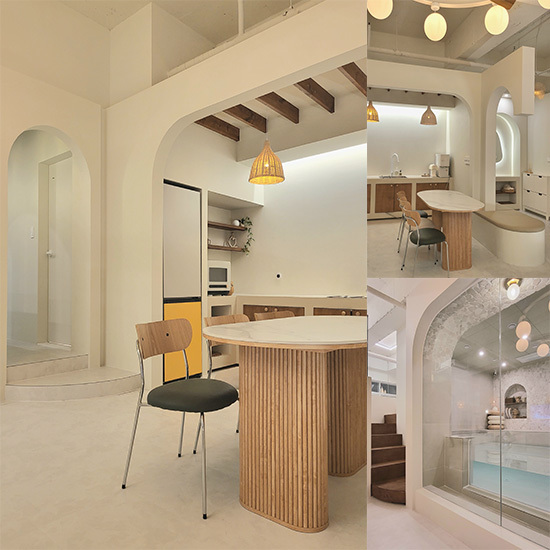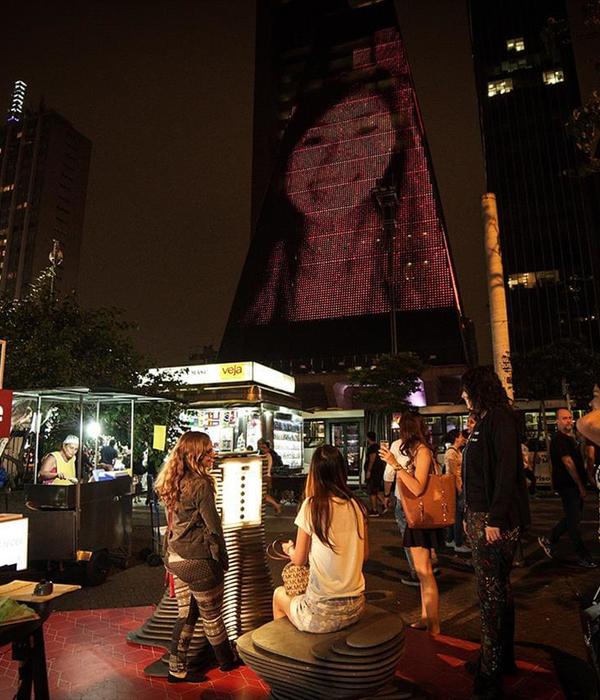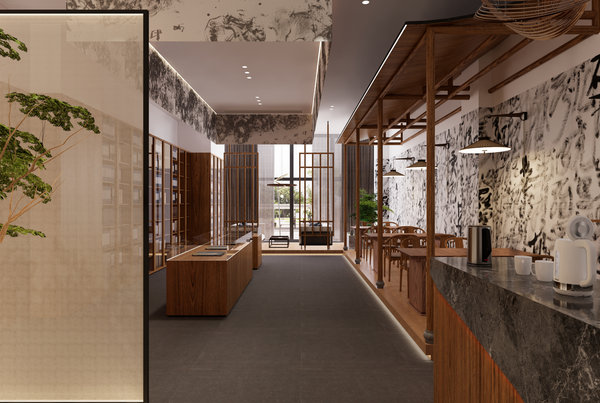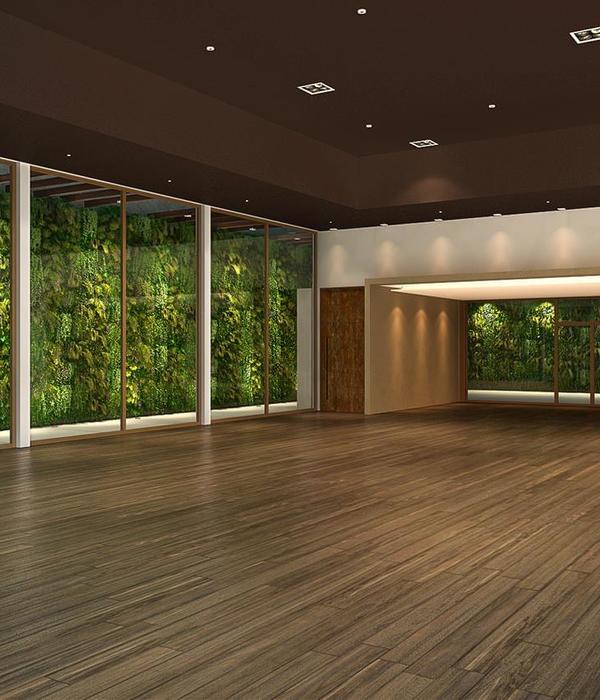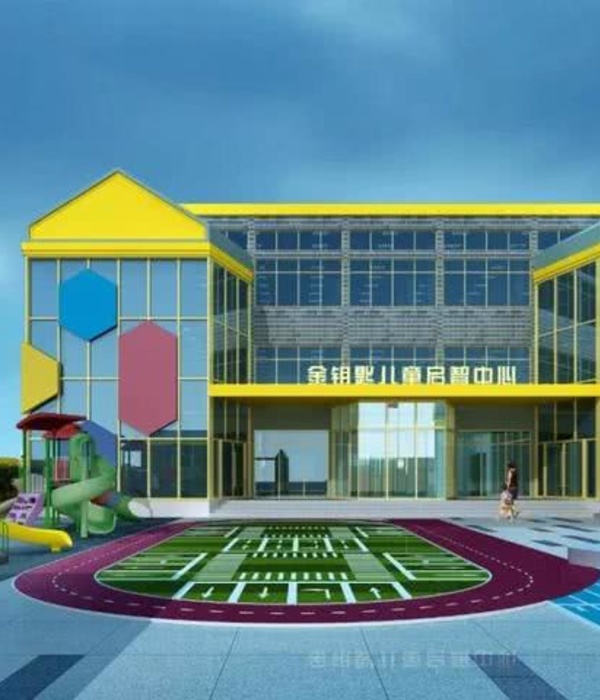(出品人 Producer:
向玲 XiangLing
王耀华Yaohua Wang
)
2015年5月1日上午,2015年世博会中国国家馆在意大利米兰隆重开馆。历经两年多设计、近一年建造的中国馆以其创新的技术、深厚的内涵、现代的设计语言完美地诠释了中国文化。这既是中国国家馆首次以独立自建馆的形式赴海外参展,同时也是中国当代建筑与世界的一次“对话”。中国馆建筑由清华大学美术学院设计团队与包括了美国和意大利在内的各专业团队通力配合完成,引起了国际社会的高度重视和关注。
Rejecting the typical notion of a cultural pavilion as an object in a plaza, the China Pavilion is instead conceived as a field of spaces. Envisioned as a cloud hovering over a “land of hope”, the Pavilion is experienced as a series of public programs located beneath a floating roof, the unique design of which creates an iconic image for the project and a unique presence within the Expo grounds.
Interview
LY: 陆轶辰
QW:蔡沁文
1
The final result of the China Pavilion didn’t use the translucent skin design as shown in the original schematic renderings? What was the main reason to change it? How was the current skin design chosen in the end?
LY
: 这个问题非常有意思,最近来问我们有关中国馆表皮的不少,背后的台词是“你们妥协了”–事实上,“妥协”这个词在我的词典里是不存在的。在网络上大家经常看到的那版效果图,是在2013年底投标阶段的效果图,之后由于涉及国家项目,我们对外没有公布过过程中的模型照片和更新后效果图。我们也没有料到这张投标阶段的效果图影响那么大,以至于大家认为最后中国馆的屋面就是投标效果图里的半透明的银色金属网。
世博会组委会对所有的场馆都有一个强行的要求,就是65%的场地面积需要使用可降解材料或绿色屋面;而在投标阶段,当时业主就咨询过是否可以在屋面上大量使用金黄色琉璃瓦,清华的设计团队当时索性建议用编织竹材来做一个更生态的遮阳屋面,一举两得–这个已经是2013年底的事了。之后从方案深化开始,一直是在思考如何用竹子来作屋面。几个好处:1,竹子在中国文化中的认同感;2,价格平宜,在中国把竹片运到意大利组装;3,最后的遮阳竹板在空间中洒下的阴影,随着时间的变幻微妙地改变着空间体验,体现抽象的中国气韵。
一个在我们这里实习过的年轻建筑师,前一阵子也通过邮件质疑我,是不是妥协了。我邮件回答了他,他很满意,说“我也觉得你不会,按咱们对项目的严苛程度来看”。我很高兴看到这个词,我们对设计的严苛始于对自己的严苛–不会妥协,但会在理解各方诉求的前提下推进。经过这几年的实践,我发现改变其实不是问题,但建筑师如何去改变,是有方法的。好的设计方法,会凝结各方的诉求,把设计带到一个更丰富的层面上去;而纯建筑学的设计探讨,路越走越窄,意义不大。
QW
: “妥协”的潜台词是竹编的效果不如银色金属网的好——其实真的想像一下,如果我们用了银色的金属网,在米兰的阳光下闪闪放光,或者是苍白的,对我个人来说并不是更好的结果,也许又会引起其他的联想。我们认为还是竹编的材质更自然内敛,在不同天气情况下有丰富的质感,跟木结构的结合也更好。
LY
: You asked a very interesting question. Recently quite a few people asked me about the skin of the pavilion. What they are saying behind is ‘you compromised’. As a matter of fact, we didn’t. The rendering that everyone finds on internet was for the competition at the end of 2013. Since then we haven’t published any updated renderings or model photos because of the confidentiality of the project. We also didn’t expect the rendering would have such an impact that people would actually think the final skin design of the pavilion was going to be locked to the translucent silver metal mesh.
The EXPO committee had a strict request for all the participants – 65% of the projection area of each pavilion should use either recyclable material or green roof; during the competition phase, our client already consulted with us that if the traditional golden porcelain tiles could be used on the roof. Our design group at that time promptly suggested woven bamboo as the alternative to make a more sustainable roof. There are a few advantages: 1. The recognition of bamboo in the Chinese culture; 2. Low cost, especially when shipped from China to Italy for the assembly. 3. The shadows which are casted by the bamboo shading panels into the main space keep altering subtly the experience. It’s an abstract symbol of the essence of the Chinese disposition.
One of the former intern architects of our studio also asked me in email if we had compromised. I replied to his email. He was satisfied and said, ‘I knew you wouldn’t, given how strict we are for our projects’. I was glad to see the word ‘strict’. How strict we are towards our projects comes from how we are towards ourselves. We wouldn’t compromise, but we would move forward while understanding the appeals from every group. After the practice of the past a few years, I’ve realized that it is not a problem for architects to make changes but how we do it requires methods. A good design method will condense all the appeals and bring the design to a much sophisticated level. On the other hand, a pure architectural design discourse will narrow the paths therefore is not as meaningful.
QW
: It seems ‘compromise’ means the final woven bamboo isn’t as good as the silver metal mesh – actually if you imagine, had we used the silver panels, the pavilion would have been shining under the strong the intense sun light in Milan now, or it would have been pale white. For me it wouldn’t necessarily have been a better result; people might also associate it with something else. It’s all personally taste if some people think the metal mesh skin would look more modern or pretty. At least I think the woven bamboo is more natural and introvert, with the texture of more richness under different weather conditions. Also it definitely has a better reconciliation with the timber structure.
▼方案深化阶段效果图(MIR, 2014年)
▼中国馆 建成照片与过程效果图对比
2
Looked from the graphic, the China Pavilion of this EXPO uses pictographic design methods and elements such as the city skyline and the curved mountain profiles. Compared with that in other countries, pictographic design seems more influential in contemporary Chinese architecture. What’s your perception of pictographic design and its impact to contemporary Chinese architecture?
LY
: 我们对这个房子“像”什么一点都不感兴趣。好的建筑就和艺术品一样,不同背景的人可以有不同的诠释,如果大家对它的说法一致,反而说明这个艺术品的厚度不够,不足以承载各种深度的信息。比如说,我们乐见:老百姓们看到的是个竹屋面;领导们看到的是传统屋顶;建筑师们看到的是胶合木结构;参数化建筑师看到的是南侧自然抛物线和北侧直线之间的数理关系……很好,很和谐–建筑师的思考就在里面。
但我们有明确反对的,就是“具象”的设计。比如说传统图案、脸谱、灯笼、剪纸这些过于具象的符号模仿或浅薄装饰,这个是价值观问题,设计师应该寸步不让。中国馆在设计过程中有过各种大家难以想象的压力,但至少在建筑层面上,我们没有妥协,一些涉及到建筑层面的“装饰”,最后在工程过程中也基本上被建筑师消解掉了。更重要的是,我们在配合的过程中,看到了业主对建筑师的信任和支持。大家现在看到的,是包括业主、清华美院各专业、总包等各个方面全力配合获得的结果。要把这些背后的努力写出来,会是厚厚的一本书。
LY
: We are least interested in what the building ‘looks like’. Good architecture is like good art. People with different backgrounds may have different interpretation to it. If the comments from everyone are the same, it means the art doesn’t have enough depth to take the various insights. For example, we would like to observe that the general public sees a bamboo roof in the pavilion; government officials see the traditional roof; architects see glulam timber structure; parametric designers see the geometric relations between the curves at the south and the folded lines at the north, etc. That’s very good and harmonious. Our thoughts as an architect are in there.
And we also have what we clearly would not want to observe, the real symbolic design. When it’s about the superficial resemblance of the symbols and ornaments, architects should firmly hold their ground because it’s a question of values. During the design process there was all kinds of pressure that people can’t imagine now, but we didn’t set back, as least in the architecture part. Some ornaments at the interface with the architecture also were basically diminished by the architects. More importantly, we observed that the client of trust and support of architects. What everyone sees now, it’s actually a result of the extensive cooperation of the client, all design departments of Tsinghua University and the contractors in all aspects. If we want to write about the effort behind it, we could get a really big book.
▼中国馆南立面山水轮廓 (摄影:Sergio Grazia)
▼中国馆北立面城市轮廓(摄影:Sergio Grazia)
▼中国馆形式生成图解
3
What was the most impressive thing for you at the construction site?
QW
:总的来说印象最深刻的事情可能是这个木结构屋顶和竹编表皮的实现,几乎是个奇迹。这样复杂时间又短的屋面要求跟我们合作的实施团队有很强的能力。比如说,在我们提供的三维模型和大量数据的基础上,要精确的处理复杂几何形带来的几百上千种不同类型的、微妙变化的构造节点,短时间内协调国内和意大利各地的加工、分类、编号、运输、组装,然后组织施工,几个月以来的工作强度非常大,效率很高。屋面的膜和竹板的安装过程也是。整个屋顶非常的“特制”,没有哪一件东西是现成的,那就意味着更多工作量。屋顶安装团队从来到走两个月没有周末,每天12-14个小时,有时还要在几乎垂直的屋面上用安全绳吊着工作。过程中有几位工程师、建造者因为喜欢做有挑战性的项目而感到有动力,挺享受这个过程。这是我们的欣赏和尊重的,我们也最愿意和这样的人互动,提供我们最大的帮助,才能一同达到最好的效果,创造这个奇迹。
另一个令我们印象深刻的是意大利施工方的做事方法和标准。意大利施工方自己有一个木工和金工作坊,他们会在作坊里做试验对复杂的节点,加工一些样品,就像我们工作室里日常做模型一样,非常有帮助。意大利施工方的一个老工程师,最后几天了,为了阳台的一个收边板隔一天从都灵跑一趟米兰,每次来带一块他们的作坊制作的样版,确认收边板符合现场的尺寸,跟我们交换意见,怎么让这块板看起来更精致。我记得我们在图纸背面画草图,陆老师还趴在阳台边去把尺寸标下来,然后老工程师再做一块样品再过来试,因为他觉得这件事很重要。到最后效果比没这样收过好太多了。
顺便也说一句,这种根据情况临场发挥对我来说也很特殊,不只是会让我想起老一代建筑师赖特、斯卡帕他们的做法。而是你会突然发现,有些解决办法的出现正是由于有了几个月工地经历的积累,建筑元素在你眼中变成另外一种存在。这个时候你看到的东西可能更立体,更有质感,解决方法也许会更出人意料,带有一种不同的灵感。这种意识在我受的建筑教育中很有限,只有通过做项目,通过和优秀的工程师、建造者合作来体验。我们曾在参与这些过程,中国馆对我们的关联就更多了一层,我们觉得它的质量,或者一种“重量”是不寻常的。这些过程也会投影在我们今后的设计中,我们甚至可能会去自发的寻找这样的“发挥”的机会。
QW
: Generally speaking what left its most marks is probably the whole process of realizing the timber roof and woven bamboo skin. It is almost a miracle. The complex geometry under such a tight schedule requires high capacity from the constructors. For example, they would need to process hundreds even more than a thousand detail elements that are slightly different from another, coordinate the fabrication, categorizing, transportation, assembly at various locations across Italy and China then organize the site activities all in such a short time. There was enormous amount of work involved in the past a few months. It was the same during the installation of the roof waterproofing and bamboo panels. The entire roof is highly custom-made, without many standard off-the-shelf elements. It means extra amount of work. The roof installers worked continuously without weekends for two months. Sometimes they had to use security cables to stay on the almost vertical parts of the roof for 12-14 hours. A few outstanding engineers and workers actually enjoyed working on challenging projects and were motivated. We appreciated and respected people like this and felt more encouraged to interact with them, offering our best help to achieve the best result. That’s how the miracle could happen.
Another important aspect for us is the working methods and standard of our Italian contractor Bodino engineering. They have their own wood shop and metal shop where they can experiment relatively complicated details and fabricate samples, just like we make study models every day in our studio. And it’s very helpful. Even during the last a few days of the construction, this senior engineer from Bodino came to Milan from Turin every day, always carrying a sample panel made in their metal shop to verify that the panel would match the dimensions of what was already constructed. We would also exchange our thoughts with him about how to make the panel more elegant and easier to install. We sketched at the back of the drawing set. Prof. Lu even climbed next to the balcony where the panel would be to mark the sample. After that the engineer made another sample on the following day. It was all because he thought it was important to reach a certain standard. The result was much better.
By the way, the on-site improvisation is always special for me, but it’s not only because it reminds me master architects like Frank Lloyd Wright or Carlo Scarpa. You will realize, some solutions could emerge, exactly because of the accumulation of the months spent on the construction site – the architectural elements exist differently in your eyes, more physical and more three dimensional. So your solutions possibly are more unexpected with somewhat different inspirations. This kind of mind-setting was limited in the architectural education I received, so I can only experience it through working on actual projects and working with excellent engineers and builders. And the China Pavilion relates to us even more as we were part of these improvisations on site. So we feel its quality and ‘weight’ is extraordinary. And it will also project to our future design; maybe sometimes we might be even automatically seeking opportunities to improvise.
▼中国馆屋面竹瓦施工过程照片(摄影:陆轶辰)
▼中国馆屋面竹瓦施工过程照片(摄影:陆轶辰)
▼中国馆屋面竹瓦施工过程照片(摄影:陆轶辰)
▼中国馆南立面幕墙细节(摄影:Sergio Grazia)
4
What was the difference between designing a temporary building and a permanent one? What’s your observation of the pursuit of ‘new’ in contemporary architecture?
LY
: 建筑是有生命的,和人一样,有长有短。对于世博会这样的展馆,它们的生命就是6个月,开馆那段时间和6月的馆日,就是中国馆生命中最华彩的时刻。但生命短,不意味着不精彩。我们可以接受中国馆最后会以某种方式结束–作为建筑师,我们会不好受,但适时结束它,其实是保护它的一种方式。现在也有说法,一些城市想把中国馆在中国异地重建,我们谨慎地乐见其第二次的生命。
由钢和玻璃代表的现代建筑在新的时候很漂亮,旧了就不那么好;而很多老教堂、老房子却越旧越有味道,很大一部分原因是石、木、金属这些自然材料可以“记录时间”。中国馆虽然用了最新的胶合木建造技术,但我们却用它来表达传统的文化精神。不但大量采用木、竹等可以留下时间痕迹的自然材料,同时我们很关注构建这些材料的过程中,如何与自然因素的融合,比如光。
LY
: Buildings have lives just like human, some long, some short. A pavilion for an event like the EXPO has only a life of six months with the apexes being the opening days and probably the ‘pavilion days’ in June. That the pavilion has a short life doesn’t mean it’s not spectacular. We could accept the China pavilion terminates in certain way – as the architect, we will not feel great, but to terminate it at the right moment is actually one way to protect it. There have been some words now that a number of cities are willing to relocate the China Pavilion to China. We will be carefully glad to see its second life.
Modern buildings made with glass and steel are all beautiful when they are new and not so when they are aged; many old churches, old houses have more and more quality as they age. A big part of the reason is that natural material such as stone and wood can ‘track the time’. Although the China Pavilion utilized the latest glulam building technology, we wanted to represent the traditional cultural spirit with it. Besides using a great amount of natural materials like wood and bamboo to record time, at the same time we also paid attention to how these materials react with natural elements such as light during the process of constructing them.
▼中国馆室外屋面竹瓦细节(摄影:Sergio Grazia)
▼中国馆室内空间(摄影:陆轶辰)
▼ 中国馆室内竹瓦光影效果(摄影:陆轶辰)
5
Is there a dialogue between the shape of the roof and the internal programs? If there is, how is it? If not, what’s your altitude regarding the relationship between the form and function?
LYC
: 我对纯粹的形式不太感兴趣,而更在乎观众在空间内部的感受。建筑被看到,是一个基本层次的事情,而更高的层次是对空间的感受。而功能是消解在空间中的。如果你们看我们当时在2013年中期的过程模型,其实有一些在建筑学层面上看,和屋面的体系更契合的。但展览建筑就是这样,取决于内部展陈的需求。这个建筑中包含着由清华美院师丹青老师设计的一块400多平米的,发光LED组成的“麦田”,展览层面上需要有一个无柱的大空间来让观众从各个角度来观看,使得屋面与内部最大的展览空间之间存在着另外一种契合。
QW
:可能我们把这两个名词可以再打开讨论。比如像陆老师刚说的,“形式”肯定不是纯粹的形式。建筑师倾向于使用某种形式,往往因为它在我们的文化或者意识形态里具有某种信息,符合这个设计的身份的人们的期望;中国馆的形式就有这样的一方面。而“功能”一词也不是仅仅是“使用功能”,也有可能人们用的方式,这里是有很大挖掘空间的。建筑师不会去过多挑战比较稳定的使用功能;但可以通过某种形式激发某一方面的使用方式,可以是视觉感受,对光、对尺度;可以是动态感受,行走、穿插;更多的是其他的。这样的互动是良性的;剩下的事可能就是程度问题,见仁见智了。不同类型的建筑这个动态平衡都不一样,对这个平衡的把握有可能让整个设计极富创造性,所以我觉得这个永远都是建筑设计中最吸引人的地方之一。
LYC
: I’m not quite interested in pure forms, but more in what the visitors feel inside the space. It’s a basic thing that architecture is to be seen, but on a higher level, to be experienced. And the functions are dissolved in the space. If you look at the study model in the middle of 2013, you’ll see maybe more interaction between the interior and the roof system, in the sense of architecture. But exhibition buildings really depend on the needs of the interior display items. The pavilion contains the illuminated LED ‘wheat field’ of 400 square meters, designed by Prof. Shi Danqing of Tsinghua University. A large, column-free space is necessary for the visitors to see the LED field from all angles which led to a different dialogue between the roof and the main exhibition space.
QW
: It’s probably more interesting if we unpack the two terms to have the discussion. For example, as Prof. Lu just said, ‘form’ never means the pure shapes. Certain forms are preferred by the architects because there are messages in them. The messages have always been there in the culture or ideology of us and they match the identity and the expectations of the design project. The form of the pavilion has to do with it. And ‘function’ is not just ‘usage’ but ‘programs’, the ways people use the building; then there’s a lot to explore. Architects wouldn’t challenge the stable usages of the building but can choose the form to stimulate one of the aspects of how the buildings are used; it can be visual experience, of light, scale; it can be movements, walking, trespassing; there are much more of others. An interaction like this is positive. The rest of the question is to which extent and how, depending on the architect. Different types of buildings have different dynamic balance as well. How to deal with the balance can make the design extremely inventive that’s why I think it will always be one of the most attractive things about architectural design.
▼中国馆室内空间(摄影:Roland Halbe)
▼中国馆室内空间(摄影:Sergio Grazia)
▼中国馆室内空间(摄影:Sergio Grazia)
6
The shape of the architecture and the interior space it forms has clear directionality. But the organization of the internal circulation seems to have its own directions. Do you agree? What do you think of the tension between the two different directionalities?
QW
:出发点是建筑师希望在最大程度上给屋顶下的展陈、麦田空间留出了自由度,这一点在建成的结果中也是能很明确看到的。比如屋面作为一个自由延展的物体“罩”在景观和麦田一米高的这个块上,所有的活动是从这个块里面掏出来的空间。人们在这个“田野”里行走的时候,屋顶则在不同的高度上出现在他们的视线中。中国馆的设计出于各种原因,只能做到这一步,而要将屋顶和下面的流线整合的更严谨,把一种无意识的张力转化成有目的的张力,则需要更微妙的技巧和设计师的敏感度。这在我们以后的设计过程中会是很有意思的,我们为此还挺乐观甚至兴奋的。
QW
: The starting point was that the architect wanted to leave maximum flexibility for exhibition items and the LED field. This intent is clearly there in the final constructed pavilion. The roof is a free style artifact floating above the continuous field of the landscape and the LED installation which is at the height of 1 meter above ground. All the public activity space is ‘carved’ out of the field. While people are meandering within the volume, they encounter the roof at different heights. For various reasons, the China Pavilion could only push to this point; to further integrate the roof and the circulation, much more skills and sensitivity would be needed to transform the tension into something more intentional. This will be more interesting point in our future design process. And we are actually optimistic even excited about it.
7
In the diagrams you described the transition between the city profile and the nature profile, do you think the same design method will appear in the subsequent design projects? In other words, regarding design, are you an architect who would like to have a different idea for each project or who would prefer the project ideas interrelate and accumulate?
LY
: 我们这一代建筑师的工作方式和盖里、霍尔他们肯定是不一样的。比如我会尽量不去画草图,而让团队不同背景的建筑师们来讨论,恰当的时候组织各专业顾问来阶段性地“批”这个设计。我们几个来主导方向。我们用大量的物理模型,来让建筑与场地“对话”,让建筑自己按它应该长成的方式“生长”。功能、造价、结构、材料都是形式生成过程中的“酵母”,而建筑师是指挥家,我们用最真诚的方式来推进设计的过程,最好的技术手段来解决设计中遇到的问题。让项目和建筑自己说话—仅此而已。之前不要去预设,只要过程充实,结果就是水到渠成的事。
LY
: The ways architects of our generation work are definitely different from that of Gehry or Holl. For example I would rather not to sketch but to have a team discussion with architects from different backgrounds, then periodically invite consultants to give critics. A few of us core members guide the direction. We quite many physical study models to let the architecture ‘talk’ with its site then let it ‘grow’. Function, budget, structure and materials are all catalysts of the generation of the form; the architect is the conductor moving the design process forward in the most honest way and solves the problems with the best technical skills. Let the project and the building speak – this is it. Without a pre-definition, as long as the process is rich, the result comes rather naturally.
▼中国馆设计过程模型
▼ 中国馆设计剖面模型
▼中国馆前期过程模型
▼中国馆屋面1:1节点大样
8
During the final completion of the project, was there any regret for you that it didn’t reach your expectations? Any stories of it?
LY
: 最遗憾的就是时间。一个项目要有很好的完成度,有三个重要的基础:设计、时间、造价。这个项目最大的特点就是它从定总包到建设完成,只有7个月的时间。建筑师是个很辛苦的职业,造价不够、时间不够,最后被妥协的往往都是设计–但在这里,我们可以这么说,整个建筑在设计层面上几乎没有任何妥协,都坚持住了。
到了最后赶进度的时候,建筑、结构、屋面、室内、机电、展陈都是同时进场,交叉施工。4000平米的建筑,120多工人(大多数是意大利人)。我和蔡沁文满场跑,控制一些对整体质量有影响的细节,我们俩有语言优势,意大利人也信服我们,很多情况下经过沟通之后他们就理解我们,帮我们修改了。到了施工的最后几天,任何施工的差错发生了就不能再调整,这个时候我们要做的就是预判问题,在意大利工人犯错之前就过去纠正,很解决问题。
QW
: 没百分之百达到预期的遗憾肯定有。要让建筑所有的细节都达到预期,图纸上的细节永远都不够,肯定要再多付出一些确保最终的质量。这就是我们为什么一呆几个月。基本上建筑师的思维方式是习惯了一遍一遍找最好的做法,施工方则因为工期和造价的压力倾向于简化,双方会为了一个细节怎么做而争执。这种情况下最好建筑师有工程层面的解决方法;如果不是你的专业范畴你没有解决办法,那就要明确的沟通想要什么,不想要什么。建筑师和施工方这种带张力的合作是行业的特点。我很欣慰的看到我们和我们的“对手”彼此尊重,有时候还互相帮助,往往能找到彼此都能接受的解决办法。
LY
: 到开馆的前一个月,我们真的是入魔了,沉在细节里不肯出来,不满足。直到开馆那天,看到那么多游客在中国馆里,突然一下子如释负重了,我们的注意力被吸引到了人们怎么用这个房子上去了。
LY
: The biggest regret is time. For one project to reach a good level of completion, there are three fundamental things: design, schedule and budget. The characteristic thing of the project is that it only had seven months between the appointment of the general contractor and the final completion. It’s a hard job to be an architect; when there isn’t enough budget or time, the design is always what’s being compromised. But here, we can say this, there’s almost no compromise in the architectural design. We held up everything.
When it was getting close to the deadline, the workers of architecture, structure, roof, interior, mechanical and exhibition were all working at the same time. There were 120 workers (most of them were Italian) working in the building of 4,000 square meters. My colleague Qinwen and I were running across the site to control the details that actually had greater impact on the overall quality. We had language advantage and somehow the trust from the Italians. In many cases they understood us and would correct the errors for us. But during the last a few days, none of the errors could be corrected. At that time what we had to do was to foresee the possible mistake and point it out before the workers made it. It was effective.
QW
: There were definitely some regrets. Basically architects are used to doing something over and over to find the best way while most contractors tend to simplify things because of the pressure of schedule and cost, so often there would be a disagreement about how to make one single detail. The best thing is that the architect has a solution; if you don’t have it because it’s not your expertise, it’s important to clearly communicate what you want and what you don’t. The tension between the architect and the contractor is always one of the characters of this profession. Gladly in most cases our ‘opponents’ and us respected even helped each other to find the solutions both could accept.
LY
: One month before the opening of the pavilion, we were obsessed in all the detail problems and still unsatisfied. On the opening day, we were suddenly released when we saw that many visitors inside the China pavilion because we were attracted by how people would use the building.
▼ 中国馆建成效果(摄影:Sergio Grazia)
▼中国馆胶合木1:1节点大样
关于该项目的更多信息:
MORE INFORMATION FROM THE ARCHITECT:
占地面积4590平方米,作为本届世博会第二大馆的中国国家馆设计理念来源于对本次米兰世博会主题和中国馆自己的主题”希望的田野,生命的源泉”的理解和思考,力图在保留展会建筑所要求的“标志性”的同时,更深地探讨如何在哲学和精神的层面上来概括地表达中国文化。
当代技术对传统文化的表达:建筑师在面对场地南侧主入口和北侧景观河的2个主立面分别拓扑了“山水天际线”和“城市天际线”的抽象形态,并以”loft”的方式生成了展览空间,形成“群山”与“屋脊”的效果,以此向中国传统的抬梁式木构架屋顶致敬。为了实现中国馆屋面轻盈和大跨度的内部展览要求,中国馆采用了以胶合木为主材的结构体系。由胶合木结构、PVC防水层、和遮阳竹板一起组成的三明治开放性屋面建构体系,即使在世界范围中也是创新的。
The theme for the China Pavilion is “The Land of Hope”. The project embodies this through its undulating roof form, derived by merging the profile of a city skyline on the building’s north side with the profile of a landscape on the south side, expressing the idea that “hope” can be realized when city and nature exist in harmony. Conceived as a timber structure that references the “raised-beam” system found in traditional Chinese architecture, the Pavilion roof also uses modern technology to create long spans appropriate to the building’s public nature. The roof is covered in shingled panels that reference traditional pottery roof construction, but are reinterpreted as large bamboo leaves that enhance the roof profile while shading the public spaces below. Designed as layered screens, these panels add texture and depth to the Pavilion’s roof and create evocative light and transparency effects below.
▼中国馆南立面
▼ 中国馆北立面
整列的麦田装置:中国馆场地是一块南北向纵深的基地,游客由场地南侧的田野景观缓缓拾阶而下,“浸”入一望无垠的“麦田”景观,由中国馆东南角不知不觉地进入到建筑内部;人们徜徉在流动的麦田装置之间,伴随着展览内容的深入,观众由大坡道来到位于建筑二层核心部位的平台,回望楼下,映入眼中的将是由22,000根LED“麦秆”阵列出的变化的壮美山河。
Beneath the roof, the building’s ground plane is defined by a landscape of wheat (the “land of hope”) that references China’s agrarian past. This natural landscape transitions seamlessly into an LED multimedia installation in the center that forms the centerpiece of the building’s exhibition program.
The Pavilion’s full exhibition and cultural offerings are experienced as a sequence of spaces, beginning with an exterior waiting area in the landscape, leading to a themed exhibition space with interactive installations and cultural offerings from different Chinese provinces. After this, visitors are guided up a gently sloped public stair to a panoramic viewing platform above the multimedia installation, after which they are guided into a multimedia space featuring a short film focusing on family reunions during China’s annual Spring Festival. This sequence concludes with visitors stepping outside the building onto a platform above the bamboo roof that enjoys expansive views of the Expo grounds.
▼回望“麦田”
▼回望“麦田”
“谷仓”影音厅:影音厅位于2层流线的顶端,空间形态体现着平面和剖面布局中的巨大张力,将会为全世界的观众播放一部10分钟有关中国人回家过年、吃团圆饭的动画。
▼影音厅效果
“飞檐走壁”的廊桥:位于影音厅外、漂浮于大坡面上的廊桥使得室外的景、自然光和新鲜空气可以自由进入内部空间;观众走上廊桥,不知不觉走上了建筑的屋面,回望入口景观并享受世博园的美好景观。随廊桥穿插回室内,将体会到整个建筑流线最高潮的部分—高耸的胶合木结构屋架构成的出口区,为观众提供了极具纪念性的空间体验。
▼廊桥效果 & 竹板外观
位于中国馆屋面最上层,是由竹条拼接的板材所组成的遮阳竹板屋面—由电脑参数化“写”出来的屋面。竹板的肌理顺着竹板的角度在屋面上“流动”,在意大利北部阳光下为中国馆披上了一层精致、温暖的竹编外袍。在中国馆内部,光线透过竹编表皮漫射进室内空间,在PVC表皮上布下的斑驳投影,随着季节和时间的变换而变化。
考虑到中国馆项目造价平宜、工期短(从确定总包到建筑落成只有7个月)、压力大等特点,建筑师与中、意建设团队一起,紧密合作,采用成熟的当地材料和建造工艺,辅以前沿的参数化技术,因地制宜地设计出最具中国气质的中国馆。所呈现的建筑效果令包括米兰世博会组委会在内的中、意各界人士关注,认为中国馆是一个非常精彩且独特的建筑设计,是“最受期待的国家馆”。
▼ 室内空间效果
▼ Site Plan
▼Plan at Level 1
▼ Plan at Level 2
▼ Plan at Level 3
▼Building Section
▼ Exploded Axonometric 爆炸轴侧
▼ Roof System Diagram 屋面系统
▼ Panel Geometry Rationalization 屋面几何面板优化
▼ Panel Geometry on Roof 屋面面板图纸
▼Panel Types Diagram 屋面面板图纸
▼Building Section and Panel Axon 外表皮构造与建筑剖面
▼ Roof Structural Details 屋面结构节点
▼ Supporter and Waterproofing Axon 结构与防水节点
项目概况
名称:2015年米兰世博会中国馆
地点:意大利米兰
项目功能:展览、餐饮、影厅、装置、纪念品销售、接待、会议、办公等
基地面积:4590 m2
建筑规模(面积):3500 平方米
设计/建筑成时间:2013-2015
业主:中国国际贸易促进会
组织者:2015米兰世博会组委会
项目总负责:苏丹
项目总监:张月、杜异
建筑设计部分:
建筑设计:清华大学美术学院 + Studio Link-Arc(纽约)
主持建筑师: 陆轶辰
项目建筑师: 蔡沁文,Kenneth Namkung
建筑设计团队:Alban Denic, 黄敬璁, 范抒宁, Hyunjoo Lee, Dongyul Kim, Mario Bastianelli, Ivi Diamantopoulou,Zach Grzybowski, Elvira Hoxha, Aymar Mariño-Maza, Yoko Fujita,邓一泓,胡辰
执行建筑师(LDI):F&M Ingegneria
结构工程师: Simpson Gumpertz & Heger + F&M Ingegneria
幕墙顾问: Elite Facade Consultants + ATLV
机电顾问: 北京清尚+ F&M Ingegneria
总体设计部分:
室内设计:汪建松
景观设计:崔笑声
展陈设计: 周艳阳、赵华森、李彩丽
装置设计:师丹青、冼枫
灯光设计:杜异,刘晓希
VI系统:管云嘉
视觉传达:顾欣,王之纲
PROJECT CREDITS
PROJECT INFORMATION
Project Name: China Pavilion for Expo Milano 2015
Award: First Prize
Client: China Council for the Promotion of International Trade
Organizer: Expo Milano 2015
Photograhper: Roland Halbe (
)
, Sergio Grazia
ARCHITECTURE
Architect: Tsinghua University + Studio Link-Arc
Chief Architect: Yichen Lu (Tsinghua University + Studio Link-Arc)
Project Manager: Kenneth Namkung, Qinwen Cai (Studio Link-Arc)
Project Team: Alban Denic, Shuning Fan, Mario Bastianelli, Ching-Tsung Huang, Hyunjoo Lee, Dongyul Kim, Ivi Diamantopoulou, Wei Huang, Zachary Grzybowski, Elvira Hoxha, Aymar Mariño-Maza, Zoe Zhou (Studio Link-Arc)
Architect and Engineer of Record: F&M Ingegneria
Structural Engineer: Simpson Gumpertz & Heger + F&M Ingegneria
Enclosure Engineer: Elite Facade Consultants + ATLV
MEP Engineer: F&M Ingegneria + Beijing Qingshang Environmental Art & Architectural Design
General Contractor: China Arts Construction and Decoration Company + Unique Europe + Bodino Engineering
Rendering: MIR
Model Photo: Zheheng Hong
Architectural Photography: Sergio Grazia
EXHIBITION, LANDSCAPE, & INTERIOR DESIGN
Project Director: Dan Su, (Academy of Arts and Design, Tsinghua University)
Design Director: Yue Zhang, Yi Du (Academy of Arts and Design, Tsinghua University)
Exhibition Design: Yanyang Zhou, Danqing Shi (Academy of Arts and Design, Tsinghua University)
Landscape Design: Xiaosheng Cui (Academy of Arts and Design, Tsinghua University)
Interior Design: Jiansong Wang (Academy of Arts and Design, Tsinghua University)
Lighting Design: Yi Du, Xiaoxi Liu (Academy of Arts and Design, Tsinghua University)
Visual Identity Design: Xin Gu (Academy of Arts and Design, Tsinghua University)
建筑师简介
陆轶辰,清华大学副教授,美国
Link-Arc建筑师事务所
主持建筑师。本科毕业于清华大学,并于耶鲁大学获得建筑学硕士学位。曾于洛杉矶摩弗西斯事务所、洛杉矶弗兰克·盖里及其合伙人事务所、纽约斯蒂文·霍尔建筑师事务所任项目建筑师,并主持重要国际项目;曾获日本文部省平山郁夫奖一等奖、耶鲁大学罗伯特·艾伦·瓦德优秀设计奖、耶鲁大学弗兰克·盖里工作室弗莱德曼设计奖提名、2006年日本“新建筑国际住宅设计竞技大奖”一等奖第一名、2014德国设计协会该年度标志奖等。2013年,清华大学美术学院团队所设计的“意大利米兰世博会中国馆”获国际竞赛第一名,陆轶辰主持了其中的建筑设计部分。
蔡沁文,美国
Link-Arc建筑师事务所
主任建筑师。本科毕业于清华大学,于康奈尔大学获得建筑学硕士学位。曾与纽约拉斐尔·维诺里建筑事务所任项目建筑师,并主持重要国际项目。2012年,加入Link-Arc,并主持了深圳小径湾规划、贵阳云景台等获奖项目;曾获2014德国设计协会该年度标志奖、第12届现代装饰国际传媒奖年度建筑设计大奖等。
MORE:
Link-Arc建筑师事务所
陆轶辰
,更多请至:
{{item.text_origin}}



